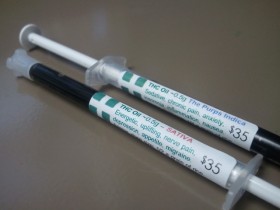A reader wrote to us asking:
Hi, my dog was diagnosed with hemangiosarcoma cancer. Can you ask if anyone knows about treating tumors of this type with cannabis oils? I have a vet prescription already but nobody really knows the best dosage of CBD/THC etc it seems.
First, an overview and some warnings. All mammals have an endocannabinoid system, so cannabis works in pretty much the same way in all mammals, but with the obvious problem that animals cannot accurately tell you how they feel or how high they are. And obviously as well, dogs and cats come in many sizes and shapes, and often weigh only a tiny fraction as much as an adult human, so even attempting to treat an animal without taking this into account is a very bad idea.
There are two main levels of dealing with cancer using cannabis. One is to treat the cancer with “ordinary” means such as radiation, chemotherapy, or surgery and then use cannabis to help ease pain and symptoms of the treatment. The other is to attempt to treat the cancer directly using cannabis, and that seems to be what you are talking about here. These approaches use different amounts and even forms of cannabis entirely, whether you are talking about a person, dog, cat, horse, or other mammal. In all cases, however, prudence dictates that you proceed cautiously and keep careful records of what you’re doing and what the results were.
If you’re dealing with pain and symptoms, it’s fairly well documented by now that cannabis can help against pain, and help restore appetite and mood in patients undergoing chemotherapy. Humans can use cannabis in almost any dose they feel comfortable with, but you’re not going to give a joint to a horse or a brownie to a dog. The solution is cannabis-infused coconut oil, which is one of the most efficient ways to extract the active ingredients from cannabis plant material and make it edible. I’ve found that if you make a batch of this at “human strength” (using the proportions in that article) and then dilute in a 1:4 ratio with plain coconut oil, you’ll have a good starting point for cats (and probably cat-sized dogs).

You’re looking for an oral dose (delivered into the mouth by oral syringe, being careful not to shoot it down the animal’s throat) of about 1 to 2 ml. that shows a positive change in attitude or behavior (usually in 30 to 90 minutes) and possibly sleepiness, but not wobbly legs or signs of dizziness or distress that would indicate they’re actually getting high. And animals should generally get indica strains only, preferably those with CBD content if possible, to help avoid them getting anxious or paranoid in case the dose is too high.
On the other hand, combating cancer directly using cannabis is definitely in the realm of experimental medicine. The method popularized by Rick Simpson involves “cooking” raw cannabis buds down in solvent until you’re left with a thick, sticky concentrate that Simpson calls “hemp oil” and almost everyone else calls “Rick Simpson Oil” (RSO). Humans are instructed to start with eating a piece the size of a third of a grain of rice daily and work up to a gram a day, or as much as they can handle. How do you measure such tiny quantities accurately for dogs or cats? How can you tell when it’s too much? And how will you ever get them to eat it, considering the solvents generally used for RSO are either naptha or alcohol, either of which are rejected by most animals with working noses?
Veterinary sources I’ve read for hemangiosarcoma recommend removing the affected organ and/or chemotherapy with cytoxan and adriamycin. If that’s not possible, then if you took a tiny bit of RSO or CO2-extracted hash oil and hid it in a doggy treat, your dog might take it. Since the goal is to get the largest dose the dog will tolerate, you’d probably want to aim for seeing that your dog was walking funny, but not cowering in a corner. You’d definitely want to insist on high CBD cannabis to avoid severe anxiety. And you should be clear that this is a last-ditch effort to attempt to save the dog’s life, and accept but not expect miracles.









